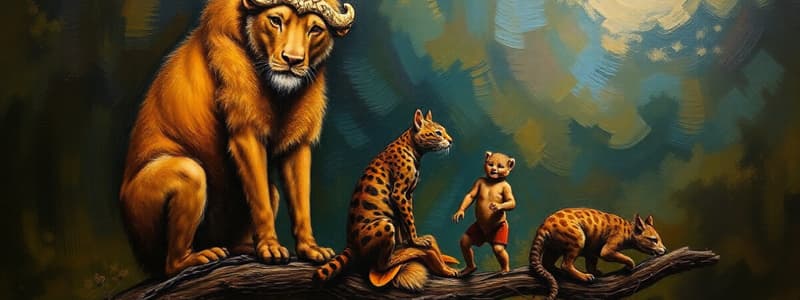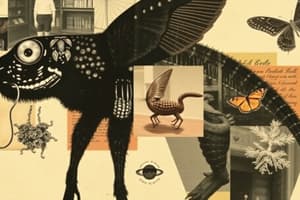Podcast
Questions and Answers
Which of the following characteristics differentiate animal cells from plant cells?
Which of the following characteristics differentiate animal cells from plant cells?
- Animal cells lack chloroplasts and cannot perform photosynthesis, while plant cells can. (correct)
- Animal cells lack a nucleus and membrane-bound organelles, while plant cells possess them.
- Animal cells have cell walls for maintaining shape and large vacuoles for water storage, unlike plant cells.
- Animal cells contain chloroplasts for photosynthesis, whereas plant cells do not.
How does sexual reproduction contribute to the evolution of animal species?
How does sexual reproduction contribute to the evolution of animal species?
- It introduces genetic variation through the combination of gametes from two parents. (correct)
- It allows for rapid population growth through a single parent.
- It simplifies the reproductive process, reducing the energy required for mating and fertilization.
- It ensures offspring are genetically identical to the parent, preserving successful traits.
Which of the following statements best describes the role of tissues in multicellular animals?
Which of the following statements best describes the role of tissues in multicellular animals?
- Tissues are rigid layers that protect the outer surface of an animal.
- Tissues are isolated cells that independently carry out life processes.
- Tissues are groupings of cells that work together to perform a specific function. (correct)
- Tissues are undifferentiated cells that provide structural support.
What is the significance of a vertebral column in classifying animals?
What is the significance of a vertebral column in classifying animals?
An organism is classified as a multicellular eukaryote. Which of the following cellular structures would be expected to be found in this organism's cells?
An organism is classified as a multicellular eukaryote. Which of the following cellular structures would be expected to be found in this organism's cells?
Flashcards
Unicellular Organism
Unicellular Organism
A life form consisting of only one cell; that single cell performs all necessary life processes.
Animals
Animals
Organisms in the Kingdom Animalia; they are multicellular eukaryotes.
Eukaryotic Cells
Eukaryotic Cells
Cells with a nucleus and membrane-bound organelles.
Multicellular organism
Multicellular organism
Signup and view all the flashcards
Evolution
Evolution
Signup and view all the flashcards
Study Notes
- Life on Earth began approximately 4.5 billion years ago.
- Early life consisted of single-celled organisms.
- Fossil records help scientists to link and date the evolution of life.
- A single-celled organism, or unicellular organism, is composed of only one cell that performs all necessary life processes.
Characteristics of Animals
- Animals belong to the Kingdom Animalia and are multicellular eukaryotes.
- The eight characteristics used to classify animals are:
- Eukaryotic cells: nucleus-centered cells
- Multicellular: having more than one cell
- Heterotrophic: they cannot produce their own food
- Ability to move: they can move freely on land or through water
- Symmetry- being the same on both sides divided by an axis, which can be bilateral or radial
- Body cavity: contain and protect vital organs, usually surrounded by fluids
- Tissue: grouping of cells to provide one function
- Vertebral Column: spine of an animal which begins at the base of the neck and extends to the tailbone
- Multicellular organisms have specialized cells for specific functions.
- Eukaryotes have cells with a nucleus and membrane-bound organelles.
- Animal cells differ from plant cells, as plant cells have chloroplasts for photosynthesis, cell walls, and large vacuoles.
- Animal reproduction can be sexual or asexual.
- Sexual reproduction requires gametes from two parents.
- Development occurs through cell production and division, fueled by food intake.
How Animals Evolved
- Evolution is the change in a species' characteristics over generations.
- Evolution can be caused by:
- Mutation: genetic material change
- Migration: relocation to a different area
- Natural selection: survival and procreation of the fittest
- Genetic drift: change in allele frequency
- Non-random mating: mate selection based on specific traits
- Cells are the basis of life and can be prokaryotic or eukaryotic.
- The five kingdoms of life are Animalia, Plantae, Fungi, Protista, and Monera.
- Single-celled organisms, made of prokaryotic cells, were the first to inhabit Earth.
- Prokaryotic means before-nucleus.
- Monera kingdom contains Eubacteria and Archaebacteria.
- All other organisms are multi-cellular and make up the remaining four kingdoms of life.
- Animals evolved from prokaryotic organisms around 2.5-1 billion years ago.
- Both plant and animal cells use aerobic respiration with mitochondria for energy.
- Scientists believe mitochondria evolved from single-celled bacteria.
- Animal cell structures are categorized for having a nucleus.
The Evolution of Animals
- Modern animals evolved from aquatic species starting around 2.5 billion years ago.
- The oldest known ancestors of animals are the metazoans, similar to worms.
- Second, came the Ediacaran animals which were a similar mix of jellyfish with tougher outer walls
- During the Cambrian period, ancestors of modern animals like insects and jellyfish emerged.
- Amphibians bridged the gap between water and land.
- Mammal-like reptiles formed around the same time as dinosaurs.
- The extinction of dinosaurs allowed mammals and vertebrates to flourish.
- Vertebrates possess a spinal column and a notochord.
- Invertebrates lack a backbone and make up most of the animal kingdom.
Evolution of Invertebrates
- Invertebrates are among the first life forms and predate vertebrates.
- Invertebrates can range from simple to highly specialized.
- Specialization caused tissues to perform specialized functions.
- Three main traits formed during the evolution of invertebrates:
- Specialization
- Symmetry
- Cephalization
- Cephalization is the formation of a head.
- The creation of a head allowed organisms to have sight, smell, and have a specific cavity for the development of a brain.
- Symmetry allows for specific bodily functions.
- Bilateral symmetry features identical sides, while radial symmetry has identical sides radiating from a central point.
- Examples of invertebrates include jellyfish, butterflies, snails, starfish, and sponges.
- Invertebrates are animals with no backbone, some examples include jellyfish, flies, leeches, and squids.
Evolution of Vertebrates
- Vertebrates possess a backbone and mostly exhibit bilateral symmetry.
- Less than 5% of animal species are vertebrates.
- All vertebrates originated from jawless fish.
- Development of cartilage and bones in fish led to the evolution of amphibians.
- Amphibians facilitated the transition from sea to land.
- Reptiles, birds, and mammals evolved from amphibians.
- This speciation took around 250 million years to develop.
- Examples of vertebrates include birds, mice, humans, snakes, and sharks.
- Vertebrates are animals with backbones, some examples include snakes, sharks, frogs, mice, birds, and humans.
Stages of Evolution of Animals
- The four eras of Earth's history are:
- Archeozoic
- Paleozoic
- Mesozoic
- Cenozoic
- The Archeozoic era spanned from Earth's formation to about 550 million years ago.
- The first life forms arose during the Archeozoic era.
- Organisms that evolved during this time include bacteria, invertebrates, amoeba, and sponges.
- The Paleozoic era lasted from around 550 to 248 million years ago, and includes the Cambrian, Ordovician, Silurian, Devonian, Carboniferous, and Permian periods.
- Organisms that evolved during this time include gastropods, fish, sharks, plants, insects, reptiles, amphibians, and some mammals.
- The Mesozoic era lasted from around 248 to 65 million years ago and includes the Triassic, Jurassic, and Cretaceous periods.
- The Mesozoic era is known as the age of the dinosaurs.
- Organisms that evolved during this time include birds and relatives of modern animals.
- The Cenozoic era began around 65 million years ago and continues to the present.
- The Cenozoic era includes the Paleocene, Eocene, Oligocene, Miocene, Pliocene, Pleistocene, and Holocene epochs.
- Mammals diversified and humans evolved during the Cenozoic era.
- A major diversification of animal species occurred during the Cambrian explosion.
Examples of Evolution in Animals
- Adaptations include the development of lungs, appendages, loss of hair, formation of the spinal column.
- Adaptations in animals result from speciation and environmental changes.
- Human evolution began in Africa around 8 million years ago from a common apelike ancestor.
- Modern humans evolved from Australopithecus ramidus over approximately 6 million years.
- As humans evolved, they lost body hair, began walking on two legs, became taller, and developed speech.
- Modern humans are known as Homo sapiens.
Studying That Suits You
Use AI to generate personalized quizzes and flashcards to suit your learning preferences.



